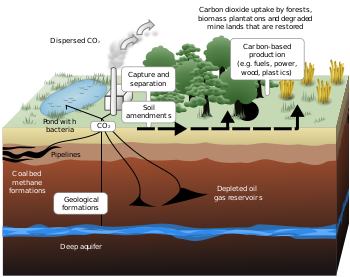 |
| Nederlands: Cartoon about climate change (Photo credit: Wikipedia) |
Also discussed here: Study assesses climate change vulnerability in urban America: Most city planners have yet to prepare for climate-related risks and the consequences. (ScienceDaily, Aug. 31, 2016)
And here: Politicization of climate change hinders adaptation in cities -- report (Brittany Patterson, E&E reporter, ClimateWire, Nov. 18, 2015
Today we review an assessment of how well 6 cities in the USA (Portland; Boston; Los Angeles; Tucson, Ariz.; Raleigh, N.C.; and Tampa, Fla.)are addressing their vulnerability to climate change. The order of preparedness is the in the same order as given with Portland at the forefront and Tampa bringing up the rear. The biggest obstacle was the lack of acknowledgment of climate change as an issue- something seen as well in Canada, in such cities as its capital city, Ottawa. The overlooked vulnerabilities includes hardening infrastructure against the increased frequency and intensity of such hazards as flooding and electrical storms and safeguarding some parts of the population, particularly older people, to such health hazards as smog events and heat waves.
“Findings demonstrate that conceptualizations of vulnerability are affected by intellectual frameworks that tend to orient around infrastructure and human health; that retrospective and prospective thinking are inter-related and affect one another; and that institutionalized forms and biases are critical. These factors shape the way that vulnerability is conceived differently than traditional expert frameworks.”
“Flooding due to rising ocean levels. Debilitating heat waves that last longer and occur more frequently. Rising rates of diseases caused by ticks, fleas, and mosquitoes, such as Lyme disease, Chikungunya, and Zika. Increasing numbers of Emergency Room visits for asthma attacks due to higher levels of ground-level ozone.”
“city planners have yet to fully assess their vulnerability to climate change, leaving serious risks unaddressed. In their evaluations to-date, they see infrastructure and risks to specific human populations as the primary areas of concern.”
“The local experts she interviewed in Boston, Los Angeles, Portland, Raleigh, Tampa and Tucson tended to focus their thinking on climate vulnerabilities in terms of infrastructure, human populations, and other local concerns. These categories do not always mesh well with the frameworks used by national experts” “At the bottom of the list fell Tampa. Despite having a high climate risk -- with thousands of people below sea level and the increased possibility of being hit by a hurricane -- the city of about 350,000 has very little in the way of adaptation plans.”
"Interviewees in Tampa overwhelmingly claimed that, mainly due to lack of political buy-in regarding climate change, their city remains one of the most vulnerable and least prepared cities in the country,"
“In 1993, Portland became the first city to put forth a plan to cut its carbon emissions. This year, the city and Multnomah County released their 2015 Climate Action Plan, which outlines actions to be taken over the next five years. These include things like boosting solar and other renewable energy, reducing the total energy use of all buildings built before 2010 by 25 percent, and achieving zero net emissions in all new buildings.”
“When we're telling ourselves, 'If we could just advance our technology around renewable energy or build a flood wall, that would solve our problems,' but in fact none of those things ever gets developed unless we have the political will to develop them and public pressure to push for them and institutions that can push for their development and expansion."
“the biggest obstacle to assessing vulnerability to climate change on the local level was the lack of acknowledgement by some institutions that climate change is a serious issue.”




















































